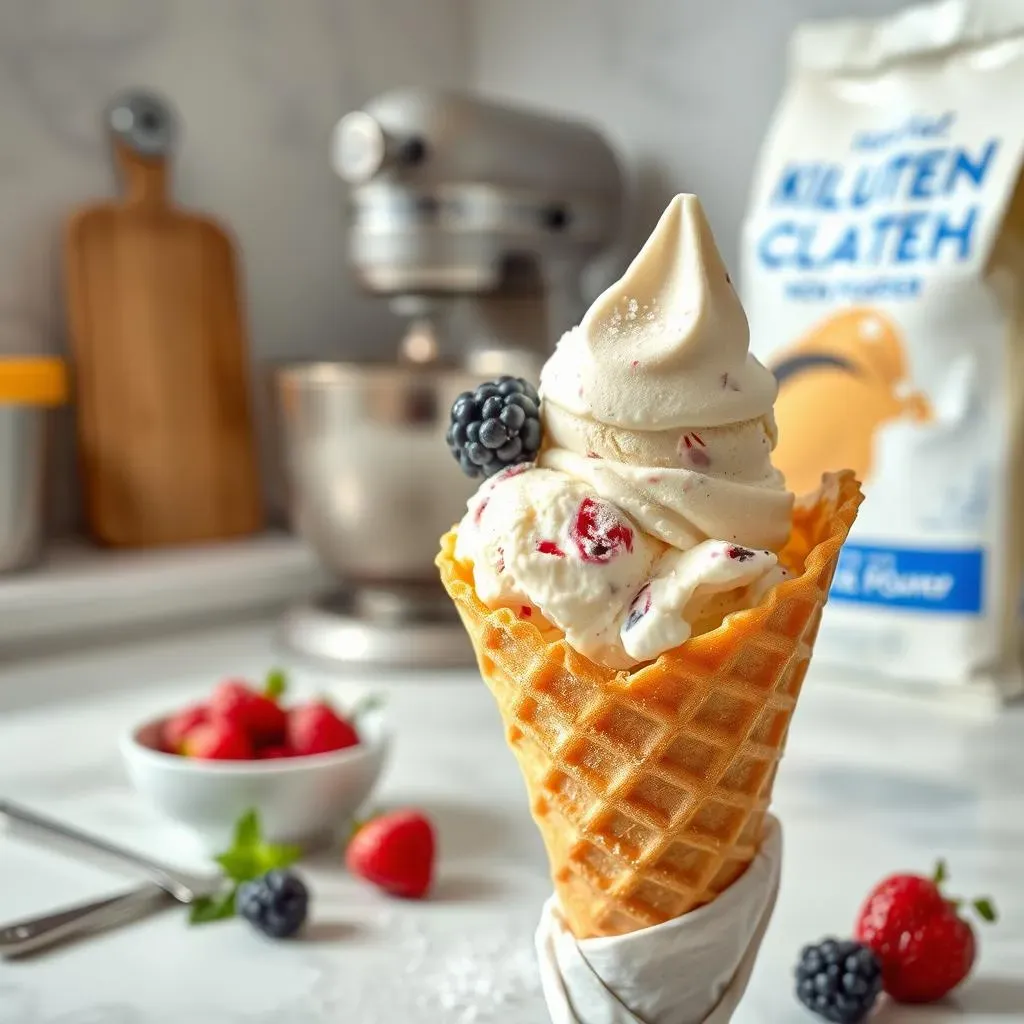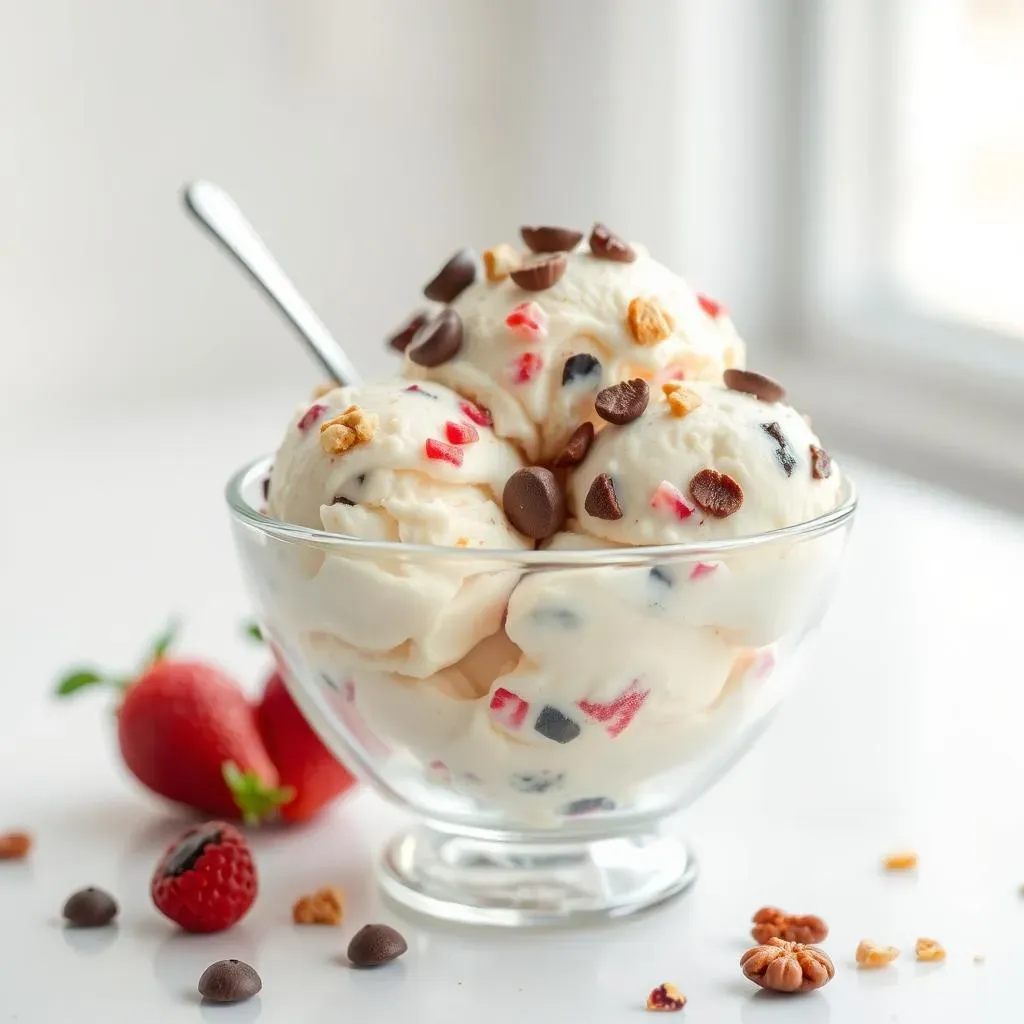Table of Contents
Ever stared longingly at a pint of ice cream, then at the skim milk in your fridge, and wondered, "can you make ice cream with low fat milk?" I know I have. The idea of a lighter, less guilt-ridden scoop is tempting, but will it even taste good? We all know that fat is what makes ice cream so rich and creamy, so using low-fat milk seems like a recipe for disaster. This article isn't going to pretend that it's as simple as swapping one milk for another. We're going to look at the science behind it, why low-fat milk can be tricky and how to work around it. We'll explore what actually happens when you try to make ice cream with low-fat milk, the sneaky tricks you can use to get a better texture, and whether the final product is something you'd actually want to eat. So, if you're ready to dive into the world of icy desserts and low-fat dairy, let's get started and see if we can pull off the impossible.
The Lowdown on LowFat Milk in Ice Cream

The Lowdown on LowFat Milk in Ice Cream
so you're thinking about low-fat milk in ice cream, right? It's like trying to make a fluffy cloud out of water – sounds a bit off. The big issue is fat. Whole milk is loaded with it, and that fat is what gives ice cream its smooth, luscious texture. Low-fat milk, on the other hand, has had a lot of that fat taken out. Think of it like this: fat molecules in milk are like tiny little pillows that keep ice crystals from getting too big and sharp. When you remove a bunch of those pillows, you're left with a less cushiony, more icy texture. That's why ice cream made with low-fat milk can sometimes end up tasting like a frozen milk slushie, rather than the creamy treat we all crave. It's not impossible, but it's certainly a different ball game.
It’s not just about the texture either. Fat also carries a lot of flavor. That's why whole milk tastes richer and creamier than skim milk. When you cut down on fat, you’re also cutting down on some of the flavor. That's why low fat ice cream often tastes a bit bland or "watered down." It's a double whammy, really – less fat means less flavor and a less desirable texture. But don't give up hope yet! There are ways to work around this, and we'll get to those soon.
Before we move on, let's recap the main differences between whole and low-fat milk in terms of ice cream making:
Feature | Whole Milk | Low-Fat Milk |
|---|---|---|
Fat Content | High (around 3.5%) | Low (1-2% or less) |
Texture in Ice Cream | Smooth, creamy, rich | Icy, sometimes grainy |
Flavor | Rich, full-bodied | Lighter, sometimes bland |
Can You Make Ice Cream With Low Fat Milk? The Science

Can You Make Ice Cream With Low Fat Milk? The Science
let's get nerdy for a second and talk about the science behind all this. When you make ice cream, you’re basically trying to freeze a liquid while keeping it smooth and creamy. The key to this is controlling the size of the ice crystals. The smaller the crystals, the smoother the ice cream. Fat molecules in milk help with this process in two main ways. First, they act as a sort of barrier, preventing water molecules from clumping together and forming large crystals. Think of it like tiny little roadblocks that keep the water from forming massive icebergs. Second, fat coats your tongue, giving that luxurious, creamy feeling. This is why we perceive full-fat ice cream as smoother – it's not just in our heads; there's actual science behind it. So, when you take away a lot of the fat, you're essentially removing those roadblocks and that coating, making it much harder to achieve that perfect creamy texture.
But what about the other ingredients? Sugar, for example, also plays a role in lowering the freezing point of the mixture, which helps to prevent large ice crystals from forming. It's like adding salt to icy roads; it makes it harder for the water to freeze into a solid block. Stabilizers, like gums and starches, are also often used in commercial ice cream to help keep everything smooth and prevent separation. These are like tiny helpers that bind the ingredients together, ensuring that the water and fat don't separate as they freeze. The more fat you have, the easier it is for the stabilizers to do their job. When you’re working with low-fat milk, you have to rely more heavily on these other ingredients to make up for the lack of fat. It’s like trying to build a house with less wood; you need to use more bricks and concrete to make it stand strong.
Here's a quick breakdown of the key players in ice cream science:
Ingredient | Role in Ice Cream |
|---|---|
Fat | Prevents large ice crystals, provides creaminess and flavor |
Sugar | Lowers freezing point, adds sweetness, helps control ice crystal size |
Stabilizers | Bind ingredients, prevent separation, improve texture |
Water | The base that freezes into ice crystals |
Making It Work: Tips for Creamy LowFat Ice Cream

Making It Work: Tips for Creamy LowFat Ice Cream
so you're determined to make delicious ice cream with low-fat milk? I admire your tenacity! It's not as simple as swapping milks, but it’s definitely achievable with a few clever tricks. The key here is to compensate for the missing fat by boosting other elements that contribute to creaminess and texture. Think of it like a balancing act – if you remove one ingredient, you need to add another to maintain the equilibrium. We're not going for "almost as good," we're going for "surprisingly delicious," right? So, let's get into the nitty-gritty of how to do it.
First off, let’s talk about stabilizers. These are your best friends when working with low-fat milk. Things like cornstarch, arrowroot, or even a touch of gelatin can make a huge difference. They help bind the water and other ingredients, creating a smoother texture and preventing those dreaded ice crystals. Don't go overboard though; a little goes a long way. Too much stabilizer, and you'll end up with a gummy mess. Another great tip is to add some non-fat dry milk powder. This will boost the milk solids content without adding extra fat, which will make your ice cream taste richer and creamier. It’s like adding an extra layer of flavor and smoothness that's not just fat-based. Finally, don't underestimate the power of sugar. It not only sweetens but also helps to lower the freezing point, which can help to keep the ice crystals small.
Here are some key strategies to boost your low-fat ice cream game:
- Use Stabilizers: Cornstarch, arrowroot, or gelatin can prevent ice crystals.
- Add Non-Fat Dry Milk: Increases milk solids for a richer taste.
- Don't Skimp on Sugar: It helps control ice crystal formation and adds sweetness.
- Consider a Custard Base: Cooking egg yolks into a custard base can add richness and stability.
- Churn, Churn, Churn: Proper churning incorporates air and helps keep the texture smooth.
Another really useful trick is to make a custard base. This involves cooking egg yolks with the milk and sugar until it thickens. The egg yolks add richness and fat-like qualities without actually adding a ton of fat. It’s a bit more work, but the results are worth it. Also, make sure you churn your ice cream properly. The churning process not only freezes the mixture, but it also incorporates air, which is essential for a light and fluffy texture. If you're using a hand-crank machine, get ready for an arm workout! But trust me, it's all part of the fun. Remember, making low-fat ice cream isn’t about replicating the exact same experience as full-fat ice cream, it’s about creating something delicious in its own right.
Taste Test: Is LowFat Ice Cream Worth It?

Taste Test: Is LowFat Ice Cream Worth It?
The Moment of Truth
Alright, we've talked the talk, now it's time to walk the walk, or rather, taste the taste. You've gone to the effort of using stabilizers, maybe you even made a custard base, and now you're staring at your homemade low-fat ice cream. The big question is: does it actually measure up? Let's be real, it won't taste exactly like full-fat ice cream. That's just the truth. But, is it still enjoyable? Absolutely. The texture will likely be different, perhaps a little less creamy, maybe a bit more icy, even with all our tricks. The flavor, too, might not be as rich and decadent as the real deal. But, if you’ve balanced the sugar and added enough flavorings, it should still be a pretty delicious treat. It's all about managing expectations and appreciating the nuances of your creation.
I think of it like this: you can’t expect a bicycle to perform like a motorcycle, but it doesn't mean it's not a great way to get around. Low-fat ice cream is its own thing, and it has its own merits. It's lighter, it’s often lower in calories, and it can be a very satisfying dessert if you approach it with the right mindset. It's not about replacing full-fat ice cream, it's about having a different option. So, before you dive in, take a moment to appreciate the effort you put in and the fact that you've created a frozen dessert with less fat, and hopefully, a whole lot of flavor.
Comparing the Scoop
Let's break down the key differences you might notice when comparing low-fat and full-fat ice cream side by side. Texture is probably the most obvious difference. Full-fat ice cream will be smoother and more velvety, whereas low-fat ice cream might have a slightly coarser, icier feel. But, this isn’t always the case. With the right techniques, low-fat ice cream can be surprisingly smooth. Flavor is another biggie. The high-fat content in regular ice cream carries a lot of flavor, so low-fat versions can sometimes taste a bit bland or watery. This is where you might want to get creative with your flavorings. Use extracts, zest, or even a touch of salt to enhance the taste. Remember, a little bit of vanilla extract can make a big difference.
And finally, the overall experience is also something to consider. Full-fat ice cream is an indulgence, a splurge. Low-fat ice cream can be a more everyday treat. It's not about deprivation, it's about moderation and making choices that fit your lifestyle. If you're watching your fat intake, low-fat ice cream can be a great option that still satisfies your sweet tooth. So, it's less of a competition and more of a "different strokes for different folks" kind of situation. It’s about choosing what makes you happy and fits your needs at the moment.
Feature | Full-Fat Ice Cream | Low-Fat Ice Cream |
|---|---|---|
Texture | Smooth, velvety | Potentially icier, can be smooth with effort |
Flavor | Rich, full-bodied | Lighter, can be enhanced with flavorings |
Overall Experience | Indulgent, occasional treat | Lighter, more everyday option |
The Verdict
So, is low-fat ice cream worth it? My answer is a definite "it depends." If you're expecting a perfect replica of full-fat ice cream, you might be disappointed. However, if you're looking for a lighter dessert option that still satisfies your sweet cravings, then absolutely, it’s worth it. It's about embracing the differences and appreciating the fact that you can make a delicious frozen treat with less fat. The key is to experiment with different techniques, find what works best for you, and enjoy the process. Don't be afraid to tweak the recipe, add your own flavor combinations, and make it your own. In the end, it's all about the joy of making something from scratch and sharing it with others. And let's be honest, who doesn't love a good bowl of ice cream, regardless of its fat content?
I think that if you want to enjoy ice cream more often, but want to watch your fat intake, then making low-fat ice cream is a great skill to have. It’s not about being perfect, it’s about enjoying the journey and the delicious results. So, grab your ingredients, get churning, and see what you can create. You might just surprise yourself with how tasty low-fat ice cream can be. And always remember that the most important ingredient in any recipe is your own passion and creativity.
The Final Scoop on Low-Fat Ice Cream
So, can you make ice cream with low fat milk? Absolutely. Will it be exactly like the full-fat version? Probably not. But with a few smart tweaks and a little patience, you can create a pretty decent frozen treat that satisfies your sweet tooth without all the extra calories. It might not be the most decadent dessert you've ever tasted, but it's a solid option when you're looking for something lighter. The key is to manage your expectations, experiment a bit, and maybe add a little extra flavoring to compensate. Sometimes, a slightly less perfect ice cream is worth it for the sake of a healthier choice. And hey, even if it’s not the best, you can always just add more toppings, right?
